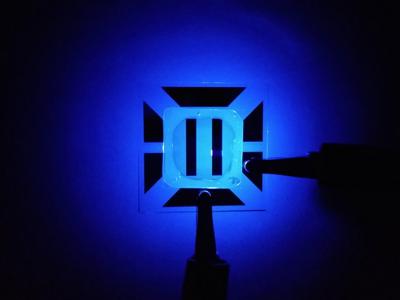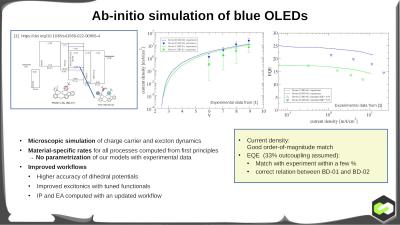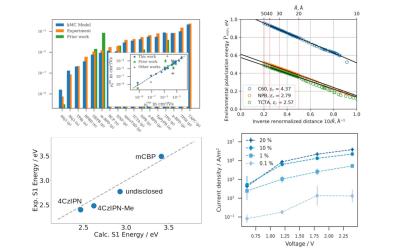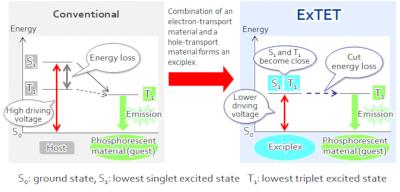OLED displays use organic materials that emit light when electricity is applied. OLEDs enable emissive, bright, thin, flexible and efficient displays. OLEDs are set to replace LCDs in all display applications - from small displays to large TV sets.

UDC OLED material performance, 2012
One of the main problems of OLED displays is the limited lifetime of the OLED materials. In past years we have seen great advances in this area, and today OLED materials are quite long lasting - with material lifetime reaching million hours or more.
Blue OLED lifetime
A blue OLED emitter is the most unstable emitter, and blue OLEDs (required to create a full-color display) suffer from short lifetimes. This is especially true for the efficient phosphorescent blue emitter - and today there's still no commercial efficient blue emitter.
The OLED industry is seeking several routes to develop an efficient blue. PHOLED pioneer Universal Display is developing a blue PHOLED, but has yet to find a commercial-ready material. Other promising route is TADF emitter technology.
The latest OLED lifetime news:
Computing material properties for OLED device simulations
This is a sponsored post by Nanomatch
To enable efficient design and improvement of OLED materials and device, the Nanomatch
software computes material properties and parameters such as HOMO, LUMO, excitation spectra,
transition moments, etc. from first principles.
Recent improvements in the ab-initio computation of material parameters enable the accurate
computation of IV and EQE of state-of-the-art OLED devices. This was demonstrated for a recently
reported exceptionally stable blue OLED.
Kyulux says it is on track to commercialize green Hyperfluorescence materials in 2023, red and blue in 2024
Kyulux gave a very upbeat presentation at SID Displayweek, during which it updated on its latest material specification and its commercialization plans.
Kyulux managed to increase the lifetime of its Hyperfluorescence emitter systems (which features an IQE of 100% and a narrow emission spectrum) quite dramatically in the past year its green material now offers a lifetime of 59,000 hours (LT95@1000 nits, top emission), while the red material is at 20,000 hours. The blue material has also increase from280 hours to 450 hours in the past year.
Idemitsu Kosan developed the world's most efficient fluorescent blue OLED emitter system
Idemitsu Kosan announced that it has developed the world's most efficient blue fluorescence OLED emitter system. Idemitsu's new system achieves an EQE of 14% (at current density of 10 mA/cm2), a lifetime of over 400 hours (LT95 @ 50 mA/cm2) and a color point of (0.14,0.08).
The new material system uses a tandem structure of two blue OLED emitter layers. Idemitsu says that by separating the region that causes charge recombination and utilizing TTF (Triplet-Triplet Fusion) it managed to achieve the high light output.
Japan Display announces a breakthrough lithographic-based OLED production method
Japan Display (JDI) announced that it has developed a new OLED deposition technology, which they refer to as eLEAP, that is cost effective and can be used to create OLEDs that are brighter, more efficient, and longer lasting compared to OLEDs produced using mask evaporation (FMM). eLEAP also enables OLED freeform deposition. JDI regards its new technology as a " historic breakthrough in display technology".

eLEAP is based on a lithographic method, and does not require any masks. The main advantage seems to be that OLED displays produced by eLEAP technology can achieve an aperture ratio of 60%, compared with FMM OLEDs which achieve a ratio of about 28%. This means that the OLED displays can be driven at lower currents - which extends the lifetime, improves the efficiency and also enables higher-peak brightness when needed.
Eliminating performance bottlenecks in OLED devices with microscopic simulations
This is a sponsored article by Nanomatch
Recent applications of the Nanomatch Toolkit to improve OLEDs:
- Charge carrier mobility
- Charge screening in OLED materials
- Doping
- Excited states in molecular thin films
Attend our talk at SID Display Week (Session 28 on May 11 2022, 10:40 AM) for further information.
Read more:
On SEL's ExTET OLED device architecture
In 2016, Researchers from Japan's Semiconductor Energy Laboratory (SEL) announced a new OLED device architecture, called ExTET ('exciplex triplet energy transfer'), that can increase the performance of OLED devices. The technology was applied for a patent in 2011.
The ExTET technology, which is a modification of the host material and the EML layer in phosphorescent OLED devices, have since been introduced to commercial AMOLED panels, increasing the efficiency and lifetime of the materials, while also lowering the drive voltage.
Samsung Display starts developing a tandem OLED for Apple's iPad
Back in 2020 we reported that Apple is worried about lifetime and burn-in issues in AMOLED displays in tablet applications, and Apple decided to adopt a tandem OLED architecture in the displays it will eventually adopt in future iPad devices.
LG Display already developed such panels for automotive applications, and according to reports it is developing a tandem LTPO AMOLED display for Apple, aiming to supply these to Apple at around 2024. According to a new report, Samsung Display has launched a project to develop tandem OLED panels as it also hopes to supply panels for Apple's future iPads.
Toray Research Center to explain its OLED device degradation analysis in an online seminar
Next week, Toray Research Center (TRC) will host an online webinar focused on OLED technologies. TRC, who supplies technical analysis and support for R&D and manufacturing, invites you to attend the online lectures at no cost, to learn more about OLED technologies and analysis of OLED devices.
One of the topics covered in these online webinars will be the degradation analysis of OLED devices. The researchers at TRC can use nine different techniques to analyze the OLED stack, looking for organic impurities, degradation products, outgas and luminescence properties of an OLED device. The researchers can also look at the sealing property of the encapsulation layer and analyze the OLED device's cathode.
Toray Research Center invites you to attend its online OLED seminars
At the end of this month Toray Research Center (TRC) will host an online webinar focused on OLED technologies. TRC, who supplies technical analysis and support for R&D and manufacturing, invites you to attend the online lectures at no cost, to learn more about OLED technologies and analysis of OLED devices.
The webinars will include recorded presentations, which will be available online from February 22 to March 08. You can register for the webinars here.
LG Display's OLED EX technology improves the brightness, lifetime, size and image quality of its OLED TV panels, to be adopted in all WOLED panels by Q2 2022
LG Display unveiled its latest OLED TV technology, branded as OLED EX. LG says that these WOLED panels combine new deuterium compounds and personalized algorithms to improve the image quality and increase brightness by up to 30%. EX is an acronym of Evolution and eXperience.
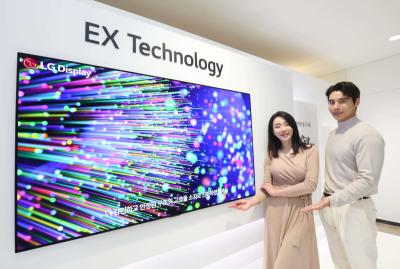
LG Display says that it has "successfully converted the hydrogen elements present in organic light emitting elements into stable deuterium". LGD extracts the deuterium compounds from water, and after stabilization, the compounds allow the OLED devices to be brighter - and also last longer.
Pagination
- Previous page
- Page 3
- Next page
